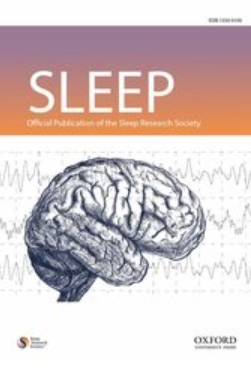在一个具有全国代表性的西班牙样本中,对 PROMIS 家长代理儿科睡眠量表进行从幼儿期到青春期的心理计量学检验
IF 5.6
2区 医学
Q1 Medicine
引用次数: 0
摘要
研究目的 使用具有全国代表性的样本,(1) 评估 PROMIS 家长代理儿科睡眠量表(西班牙文译本)的因子结构;(2) 检验这些量表在不同性别以及儿童和青少年不同发育时期的不变性;(3) 使用项目反应理论 (IRT) 确认量表的信息和精确度;(4) 提供基于年龄的常模信息。方法 对具有全国代表性的 5525 名西班牙 5-16 岁儿童和青少年(56.1% 为男孩)的父母进行抽样调查,他们填写了西班牙文翻译的父母代理简版睡眠障碍和睡眠相关障碍量表。我们进行了确证因子分析 (CFA)、不变量分析和分级反应 IRT 分析。结果 对三个年龄组(幼儿期:5-8 岁;中幼儿期:9-12 岁;青少年期:13-16 岁)的男性和女性分别进行的 CFA 表明,除一个项目外(睡眠连续性项目["我的孩子整晚都在睡觉"]的载荷较低,因此在后续分析中删除了该项目),所有项目的载荷都很高。在每个年龄组中,这两个量表的得分在不同性别间均无差异。通过 IRT 分析,两个量表都显示出较高的信息量和精确度,从略低于特质平均值到略高于特质平均值的两个标准差。结论 家长代理 PROMIS 儿科睡眠障碍和睡眠相关损伤量表的简易版具有很强的心理测量特性,再加上基于年龄的标准,表明这些量表可能会在研究和临床应用中发挥作用。本文章由计算机程序翻译,如有差异,请以英文原文为准。
Psychometric Examination of the PROMIS Parent Proxy Pediatric Sleep Measures from Early Childhood to Adolescence in a Nationally Representative Spanish Sample
Study Objectives To use a nationally representative sample to (1) evaluate the factor structure of the PROMIS parent proxy pediatric sleep scales (Spanish translation), (2) examine the invariance of these scales across sex and across different developmental periods of childhood and adolescence, (3) confirm the information and precision of the scales using item response theory (IRT), and (4) provide age-based normative information. Methods Parents of a nationally representative sample of 5,525 Spanish children and adolescents ages 5-16 years (56.1% boys) completed the Spanish translation parent proxy short versions of the Sleep Disturbance and Sleep-Related Impairment scales. We conducted confirmatory factor analyses (CFA), invariance analyses, and graded response IRT analyses. Results CFAs conducted separately on males and females within three age groups (early childhood: ages 5-8 years; middle childhood: ages 9-12 years; adolescence: ages 13-16 years) indicated all items had a substantial loading with one exception (the sleep continuity item [“my child slept through the night”] had a substantially lower loading and was removed for subsequent analyses). The scores on the two scales demonstrated invariance across sex within each age group. Using IRT analyses, both scales showed a high degree of information and precision from slightly below the trait means to slightly above two standard deviations above the trait means. Conclusions The strong psychometric properties of the short versions of the parent proxy PROMIS pediatric sleep disturbance and sleep-related impairment scales, coupled with age-based norms, suggests these scales are likely to be useful for research and clinical applications.
求助全文
通过发布文献求助,成功后即可免费获取论文全文。
去求助
来源期刊

Sleep
Medicine-Neurology (clinical)
CiteScore
8.70
自引率
10.70%
发文量
0
期刊介绍:
SLEEP® publishes findings from studies conducted at any level of analysis, including:
Genes
Molecules
Cells
Physiology
Neural systems and circuits
Behavior and cognition
Self-report
SLEEP® publishes articles that use a wide variety of scientific approaches and address a broad range of topics. These may include, but are not limited to:
Basic and neuroscience studies of sleep and circadian mechanisms
In vitro and animal models of sleep, circadian rhythms, and human disorders
Pre-clinical human investigations, including the measurement and manipulation of sleep and circadian rhythms
Studies in clinical or population samples. These may address factors influencing sleep and circadian rhythms (e.g., development and aging, and social and environmental influences) and relationships between sleep, circadian rhythms, health, and disease
Clinical trials, epidemiology studies, implementation, and dissemination research.
 求助内容:
求助内容: 应助结果提醒方式:
应助结果提醒方式:


